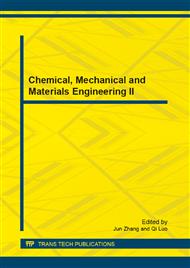[1]
M. H. Frey and D. A. Payne: Phys. Rev. B Vol. 54 (1992), p.3158
Google Scholar
[2]
M. Zgonik, P. Bernasconi, M. Duelli, R. Schlesser, P. Günter, M. H. Garrett, D. Rytz, Y. Zhu and X. Wu: Phys. Rev. B Vol. 50 (1994), p.5941
Google Scholar
[3]
G. Arlt, D. Hennings and G. Dewith: J. Appl. Phys. Vol. 58 (1985), p.1619
Google Scholar
[4]
J. Wang, B. K. Xu, S. P. Ruan and S. P. Wang: Mater. Chem. Phys. Vol. 78 (2003), p.746
Google Scholar
[5]
J. Wang, G. Song and J. Q. Qi: Ferroelectrics Vol. 355 (2007), p.165
Google Scholar
[6]
J. Yuk and T. Troczynski: Sens. Actuators B: Chem. Vol. 94 (2003), p.290
Google Scholar
[7]
J. J. Urban, W. S. Yun, Q. Gu and H. Park: J. Am. Chem. Soc Vol. 124 (2002), p.1186
Google Scholar
[8]
W. S. Yun, J. J. Urban, Q. Gu and H. Park: Nano Lett. Vol. 2 (2002), p.447
Google Scholar
[9]
R. Meyer Jr, R. R. Shrout and S. Yoshikawa: J. Am. Ceram. Soc. Vol. 81 (1998), p.861
Google Scholar
[10]
J. Yuh, J. C. Nino, and W. M. Sigmund: Mater. Lett. Vol. 59 (2005), p.3645
Google Scholar
[11]
D. Li and Y. Xia: Adv. Mater. Vol. 16 (2004), p.1151
Google Scholar
[12]
S. Iijima: Nature Vol. 354 (1991) p.56
Google Scholar
[13]
M. Morales and C. M. Lieber: Science Vol. 279 (1998), p.208
Google Scholar
[14]
C. R. Martin: Science Vol. 266 (1994), p. (1961)
Google Scholar
[15]
W. Han, S. Fan, Q. Li and Y. Hu: Science Vol. 277 (1997), p.1287
Google Scholar
[16]
C. Schönenberger, B. M. I. van der Zande, L. G. J. Fokkink, M. Henny, C. Schmid, M. Krüger, A . Bachtold, R. Huber, H. Birk and U. Staufer: J. Phys. Chem. B Vol. 101 (1997), p.5497
DOI: 10.1021/jp963938g
Google Scholar
[17]
W. Sigmund, J. Yuh, H. Park, V. Maneeratana, G. Pyrgiotakis, A. Daga, J. Taylor and J. C. Nino: J. Am. Ceram. Soc. Vol. 89 (2006), p.395
DOI: 10.1111/j.1551-2916.2005.00807.x
Google Scholar
[18]
D. Li, J. T. McCann, Y. Xia and M. Marquez, Electrospinning: J. Am. Ceram. Soc. Vol. 89 (2006), p.1861
Google Scholar
[19]
R. Ramaseshan, S. Sundarrajan, R. Jose and S. Ramakrishna: J. Appl. Phys. Vol. 102 (2007), p.111101
Google Scholar
[20]
Z. Y. Li, H. N. Zhang, W. Zheng, W. Wang, H. M. Huang, C. Wang, A. G. MacDiarmid and Y. Wei: J. Am. Chem. Soc. Vol. 130 (2008), p.5036
Google Scholar
[21]
D. J. Yang, I. Kamienchick, D. Y. Youn, A. Rothschild and I. D. Kim: Adv. Funct. Mater. Vol. 20 (2010), p.4258
Google Scholar
[22]
Z. X. Dong, S. J. Kennedy and Y. Q. Wu: J. Power Sources Vol. 196 (2011), p.4886
Google Scholar
[23]
Y. Z. Long, M. Yu, B. Sun, C. Z. Gu and Z. Y. Fan: Chem. Soc. Rev. Vol. 41 (2012) 4560
Google Scholar
[24]
B. M. Kulwicki, Humidity sensors, J. Am. Ceram. Soc. Vol. 74 (1991), p.697
Google Scholar
[25]
K. S. Chou, T. K. Lee and F. J. Liu: Sens. Actuators B: Chem. Vol. 56 (1999), p.106
Google Scholar


